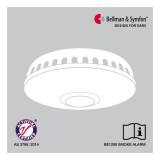
24 25
1
2
3
4
5
NEVER
Planning your escape route
1 Check room doors for heat or smoke. Do not open a hot
door. Use an alternate escape route. Close doors behind you
as you leave.
2 If smoke is heavy, crawl out, staying close to oor. Take short
breaths, if possible, through a wet cloth or hold your breath.
More people die from smoke inhalation than from ames.
3 Get out as fast as you can. Do not stop for packing. Have a
prearranged meeting place outside for all family members.
Check everybody is there.
4 Call the Fire and Rescue Services from a neighbour’s house or
mobile phone. Remember to give your name and address.
5 NEVER re-enter a burning house.
Alarm limitations
Limitations of smoke alarms
Smoke alarms have signicantly helped to reduce the number of re fatalities in countries
where they are widely installed. However independent authorities have stated that they
may be ineective in some circumstances. There are a number of reasons for this:
Limitations of radio signals
The BE1481 Smoke alarm from Bellman & Symfon is very reliable and is tested to high
standards. However, due to its relatively low transmitting power and limited radio range
(required by regulatory bodies) there are some limitations to be considered:
Do not overload electrical circuits.
Keep matches away from children.
Never smoke in bed. In rooms where
you
do smoke, always check under
cushions
for smoldering cigarettes
and ashes.
Service central heating
systems regularly.
Be sure all electrical appliances
and tools have a recognized
approval label.
This device cannot protect all persons
at all times. It may not protect against
the three most common causes of
fatal res:
Smoking in bed.
Leaving children at home alone.
Cleaning with ammable liquids,
such as petrol.
Further information can be obtained
from the Fire and Rescue Services.
Smoke alarms will not work if the
batteries are depleted or if they are
not connected. Test regularly and
replace the entire smoke alarm when
it fails to operate.
Smoke alarms will not detect re if
sucient smoke does not reach the
smoke alarm.
Smoke may be prevented from
reaching the smoke alarm if the re
is too far away, for example, if the re
is on another oor, behind a closed
door, in a chimney, in a wall cavity, or
if the prevailing air draughts carry the
smoke or heat away.
Installing smoke alarms on both
sides of closed doors and installing
more than one smoke alarm as
recommended in this leaet very
signicantly improve the probability
of early detection.
The smoke alarms may not be heard.
The radio link to the supplementary
Visit receivers may not work due to in-
terference or due to the signal being
blocked by furniture, renovations etc.
A smoke alarm may not wake a per-
son who has taken drugs or alcohol.
The smoke alarms may not detect
every type of re to give sucient
early warning. They are particu-
larly ineective with: res caused
by smoking in bed, escaping gas,
violent explosions, poor storage of
ammable rags and/or liquids, (for
example petrol, paint, spirits etc.),
overloaded electrical circuits, arson,
children playing with matches.
Smoke alarms don’t last indenitely.
We recommend replacement after
10years as a precaution.
EN
























